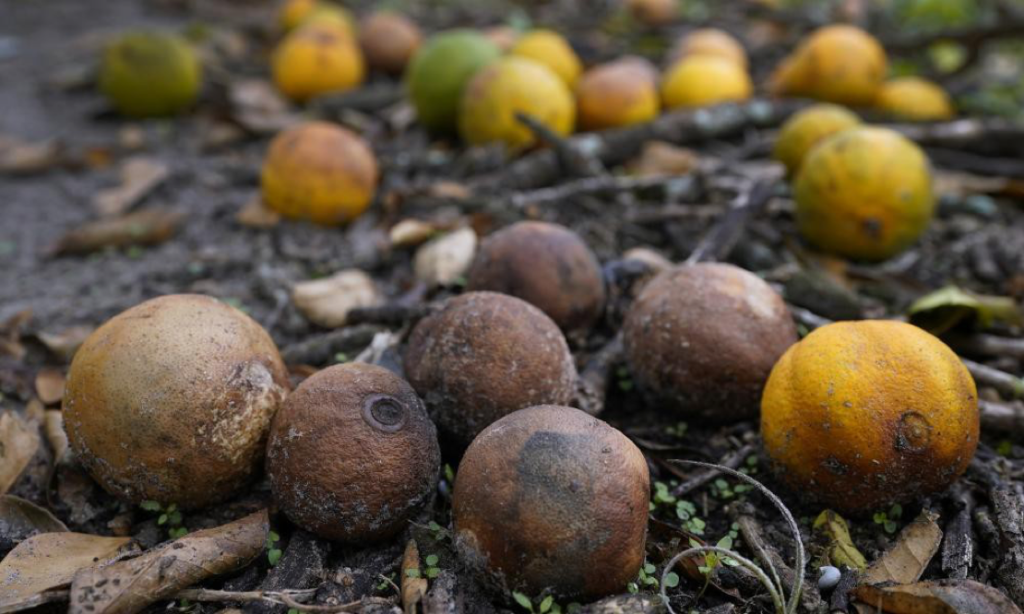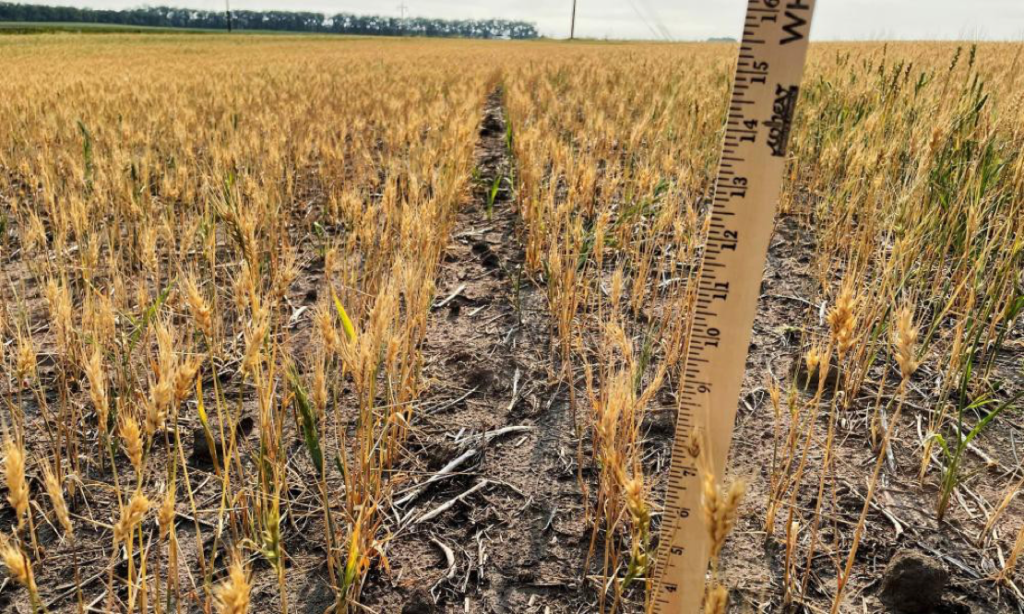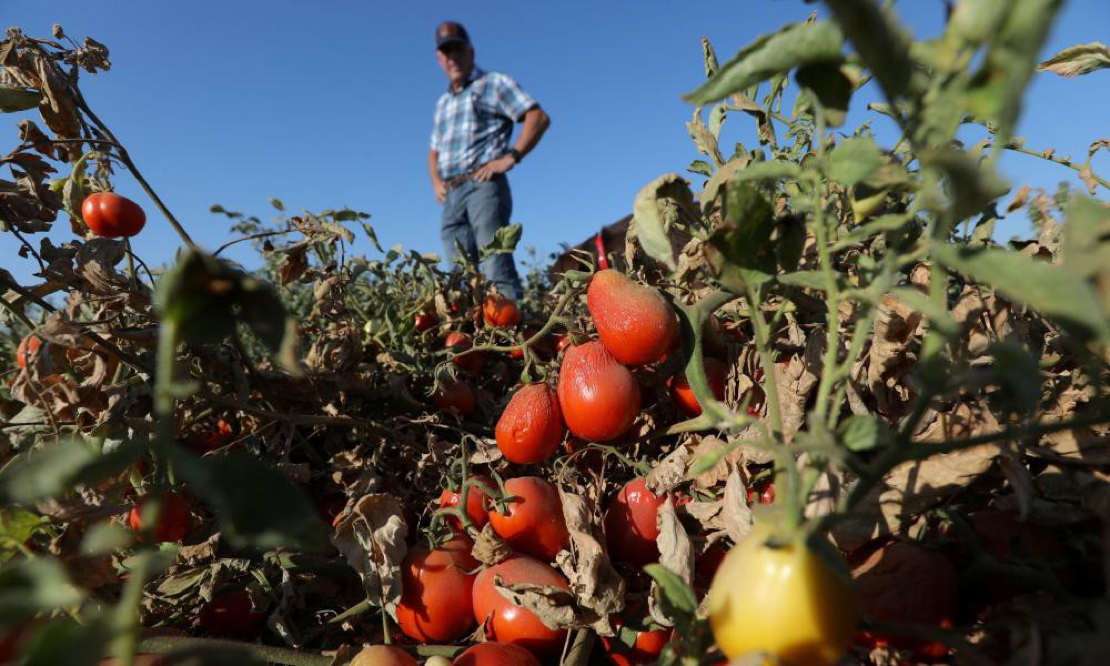Crops are struggling to grow – and produce the same yields – as they would under normal weather conditions
From Hurricanes Fiona and Ian, to flooding in eastern Kentucky and a record dry summer as the western US entered its 22nd year of a once-in-a-millennium megadrought, the US has already seen more than two dozen major climate disasters with losses exceeding $1bn (£864m).
On top of this economic toll, extreme weather is also upending the food system in the US and much of the world. As the climate crisis causes temperatures to rise, precipitation patterns to shift and drought conditions to lengthen, many crops are struggling to grow – and produce the same yields – as they would under normal weather conditions. In some parts of the country, crops that require dry conditions are getting too much rain, while in others, they’re not getting enough.
Changes to growing seasons, limitations on water rights and increasingly powerful storms are all forcing growers to consider whether to shut down, relocate or otherwise alter their operations. Extreme weather events are also disrupting the shipping of food across the country and world.
These five crops tell the story of the havoc the climate crisis is already causing.
Florida’s oranges torn off trees

After Hurricane Ian ripped through Florida’s Gulf coast counties in late September, citrus growers in the state’s main agricultural counties began reporting that 50% to 90% of their fruit had been torn off the trees by high winds and rain.
The hurricane “came right up through the heart of the citrus belt”, said Ray Royce, executive director of the Highlands Citrus Growers Association. Royce reports that in some counties growers have lost as much as 80% of their fruit. Florida orange growers were already facing a challenging year as greening disease, an invasive bacterium that thrives in warm climates and can kill trees and cause fruit to drop early, hit their plants.
The US Department of Agriculture (USDA) predicted that the state will produce 28m boxes of oranges this season, down 32% from the previous season. This would be the smallest harvest since 1943. And the impact of Hurricane Ian may not yet be over, Royce said. In some areas, the storm didn’t just cause fruit to fall, but entirely uprooted or flooded trees.
Although this storm was particularly devastating, he adds that Florida citrus growers have weathered difficult hurricane seasons before, such as Hurricane Irma in 2017. “We’re an industry that’s at the mercy of the weather.”
Rice left unplanted amid drought

Just three crops – rice, wheat and corn – provide nearly half of the world’s calories. And this year rice had a particularly tough growing season.
In California, rice farmers sowed the lowest number of seeds since the 1950s. According to the California Rice Commission, only 250,000 acres of rice will be harvested this year, about half of a typical season.
“Reservoirs were so low and the snowpack was so bad that literally half the crop was unplanted,” said Daniel Sumner, professor of agricultural economics at UC Davis. Although rice growers generally have very senior water rights, which means they’re the first ones entitled to any available water, there just wasn’t enough water for growers to make it through a season, he said, so many opted not to plant. This past year marked California’s fourth in a row facing drought.
According to a report published by Sumner and his colleagues at UC Davis, California’s Sacramento River valley – which usually exports about half its rice to China and Japan – is facing a $1.3bn (£1.1bn) economic loss, with 14,300 agricultural jobs lost.
California’s tomato crop dwindles

In August, the USDA forecasted that California would only grow 10.5m tons of tomatoes, down 10% from its estimates at the beginning of the year, as drought causes them to dry up on the vine.
California usually produces about 30% of the world’s processing tomatoes – the tomatoes used in paste, sauce and ketchup. But researchers predict that the global supply of processing tomatoes could fall by 6% in the next 30 years due to climate change.
Even though tomatoes are “an incredibly efficient user of water”, Sumner said, the drought “was even worse than people could have imagined”.
The high demand and reduced supply are reflected in tomato prices. Going into this growing season, Sumner says tomatoes reached the highest contract prices on record – about $100 (£86) per ton compared with last year’s record $90 (£78) per ton.
As temperatures increase in current tomato-producing regions, like California and Italy, the plants may no longer thrive, and growers could begin shifting their work to cooler climates, like northern California and China.
Wheat scorched by heat, waterlogged by rains

As the war in Ukraine cut off the country’s large wheat exports, wheat growers across the world faced a difficult year due to extreme weather. Heatwaves across France, Spain, and India scorched wheat crops, while US growers struggled to survive a dry winter and then a waterlogged spring.
In the US, growers typically plant hard red winter wheat, used in bread, in the fall and sow spring wheat, for bagels and pizza, in the spring. The winter wheat harvest fell 25% this year as drought hit midwestern states like Kansas. Then, high rainfall and a surprise spring blizzard flooded spring crops.
Researchers at the Environmental Defense Fund predict that Kansas will only continue to see winter wheat yields drop – by 2030, 8% of Kansas counties could see winter wheat yields fall by more than 5%. To get ahead of climate change, scientists around the world have begun breeding new varieties of wheat. But according to a study published in Nature earlier this year, climate change still might outpace any yields from those new crops.
New Mexico’s green chilis flooded by monsoon season

In southern New Mexico, record rainfall disrupted the state’s green chilli harvest. At Cinco Estrella Chile Farms in Lemitar, owner Glen Duggins says a combination of heavy rainfall and a labor shortage flooded his fields and then overtook the green chilli crop with weeds.
“Back in the day we packed 800 sacks [a day] regularly. I didn’t expect to do that now, but we should have been able to do 300 to 400 a day,” said Duggins. But his team didn’t even harvest 1,000 sacks over the whole season, from late July to early October. Green chilli “likes dry weather, this was a little too much”.
The green chilli plant grown in New Mexico thrives best in temperatures between 70F (21C) and 85F (29C). Too hot and the fruit won’t form. Too much rain and the roots will begin to rot.
Normally, southern New Mexico provides the perfect climate for the chilli harvest. But this year, parts of the state recorded their wettest monsoon seasons since 1893. Although the state struggled with severe drought early in the summer – with 45% of the state rating in “exceptional” drought, according to the US Drought Monitor – only about 1% of the state was still in that high state of drought by the end of monsoon season.
Duggins is optimistic that he’ll still be able to harvest some of his crop going into the red chilli season – when the green chilli plant begins to ripen – but if profits continue to fall, he’s worried he and his neighbors will have to consider shutting down their farms.




